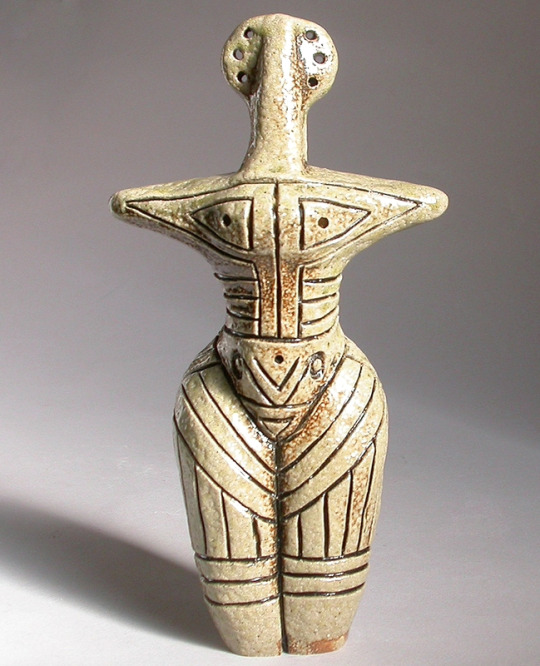#cucuteni trypillian goddess
Explore tagged Tumblr posts
Text

“Cucuteni Trypillian Goddess" article source
Cucuteni-Trypillian:
The Cucuteni-Trypillian culture, also known as Cucuteni culture (Romania) or Trypillian culture (Ukraine), is a Neolithic archaeological culture which existed from approximately 4800 to 3000 BC, from the Carpathian Mountains to Moldova and Ukraine, encompassing an area of more than 35.000 square km.
#neolithic europe#eastern europe#cucuteni trypillian goddess#statuary#ukraine#romania#Cucuteni-Trypillian culture#Cucuteni culture#Trypillian culture
129 notes
·
View notes
Text

cucuteni-trypillian goddess
when cultural art is a mirror from past to present. here the idealized representation of the self is a love letter to future generations. she said stripes are in fashion... now and forever!
11 notes
·
View notes
Text
Archaeological evidence suggests that the domestication of horses and the formation of nomadic horse clans first occurred in a region which is now Kazakhstan around 4000BCE. These people were part of a larger ethnic group which Marija Gimbutas has named the Kurgans, for the small mounts or hills these people build on top of their pit graves. These early patriarchal Kurgancultures from the Eurasian Steppes moved, in 3 waves of expansion, into the Mid European area of the Cucuteni-Trypillian civilizations: Old Europeans who originated from Anatolia. (Marija Gimbutas; The Prehistory of Eastern Europe, 1959). The Cucuteni-Trypillian had the largest settlements in Neolithic Europe of between 10.000 and 50.000 people based on an agricultural gift economy model ofgreat abundance. Known for their pottery, use of copper, and for the invention of the wheel, the peaceful Goddess loving equalitarian communities of the Cucuteni co-existed for a while together with the Kurgan invading groups who settled in the region. (J.P. Mallony; In search of the Indo-Europeans, 1989). That there was cultural exchange between the sky-God worshipping, warring horse riders and the peaceful Goddess honouring agricultural communities that resulted in hybrid cultures, is evident from many grave finds in what is now Hungary, and most noticeably in the Usalova culture of the area of the mouth of the river Danube. It is in this cross-cultural meeting place that the Horse Goddess first arises and Epona-Rhiannon has Her roots.
It feels appropriate that our Goddess of Love finds part of Her origin at the merging point of two diverse and apparent opposite cultures. Her Scythian priestesses found buried in what Vicky Noble calls the ‘Dakini’ (or tree-) pose, connect to the sacred sexual aspect of this Goddess of Horse and Moon. (Vicky Noble: The Double Goddess) We have, of course, no clear knowledge of how Her worship manifested or precisely what ceremonies were held to celebrate the Goddess we now call Rhiannon-Epona, however it feels significant that this culture and time is also where we find the source of the myth of the Amazons. A significant percentage of horse riding Scythian-Sarmatian "warrior graves" on the lower Don and Danube, as well as far away on the lower Volga, contained ‘females dressed for battle as if they were men’, a phenomenon that probably inspired the Hellenistic Greek myths. (David Anthony ‘The Horse, the Wheel, and Language: How Bronze-Age Riders Shaped the Modern World’ Princeton University Press. 2007).
All Cucuteni and hybrid settlements were abandoned by 2750BCE, probably through a combination of further waves of Kurgan invasion and climatic change. Climatic shifts brought a period of arid, cool and drought prone times to Europe, less sustaining of agricultural practices in a period known as the Sub-Boreal Phase. The genetic lineage of the Cucuteni-Trypillian people was however not lost and makes a significant contribution to European DNA. (Luigi Luca Cavalli-Sforza; Analysis of human evolution haplo-blood group genetics. Nature Magazine). In other words, the ancestors who worshipped Epona/Rhiannon did not die out, and with them survived their Goddesses.
Later in time, Epona was brought to Gaul by the Sarmatian cavalry of the Romans, and so eventually as far North as the edges of the Roman Empire, where we have found Her images at Hadrian’s Wall. The merging of the Romans with the local population of Britannia’s lands meant that Rhiannon–Epona found a much wider resonance amongst followers, priestesses and devotees across a greater geographical area then Her original region of Wales. She is believed to have been widely honoured and celebrated out at woodland altars under the moonlight. (Robert Hutton: Pagan Britain, 2014)
Soetens, Katinka. The Teachings of Rhiannon Part 1: Sacred Sexual Priestess Empowerment (p. 12)
24 notes
·
View notes